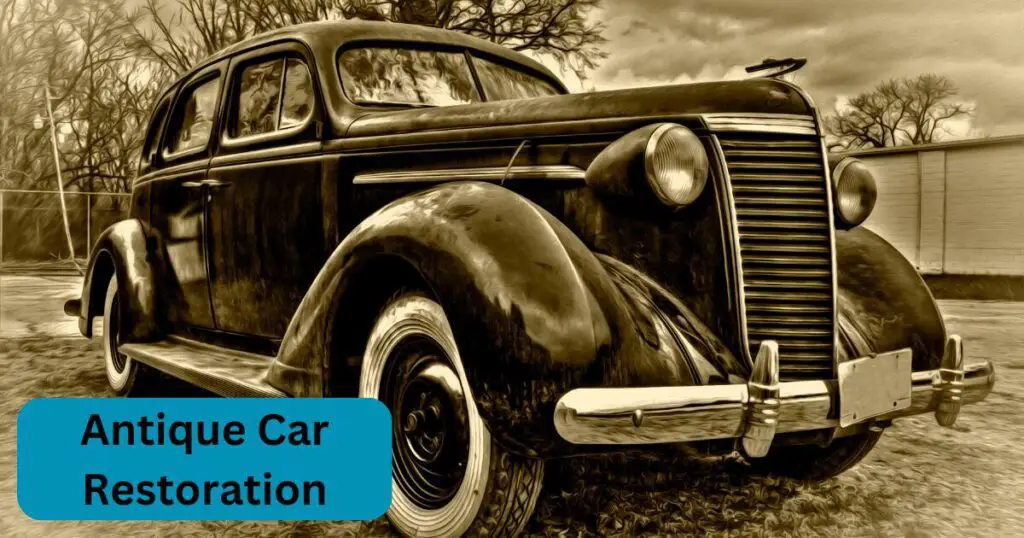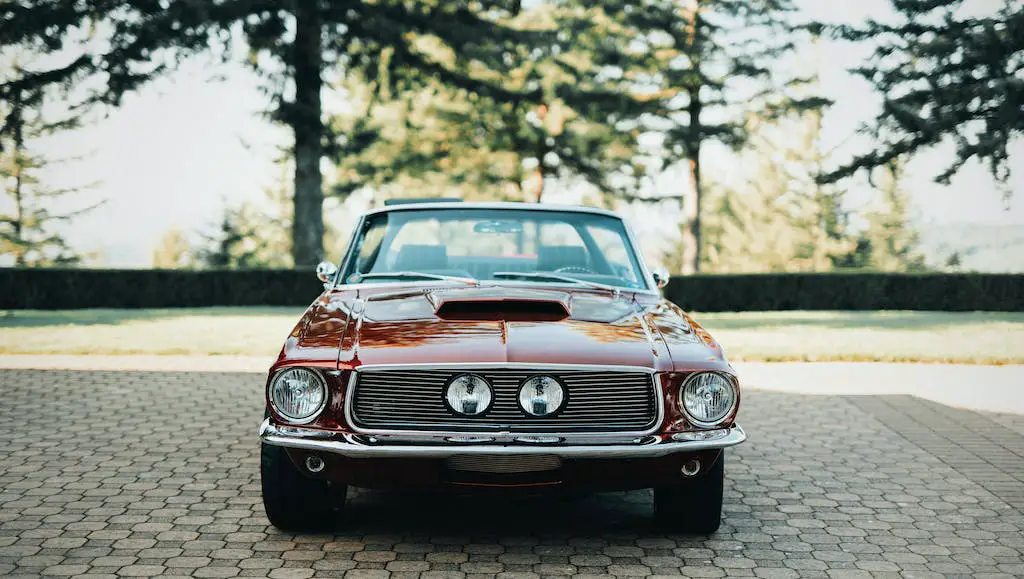Antique automobile restoration transcends mere avocation; it stands as an impassioned odyssey that time-travels the beholder. Within this all-encompassing exposition, we shall furnish you with invaluable discernments, stratagems, and legerdemain to embark upon your individual sojourn of rejuvenating vintage automobiles. Whether you traverse as a seasoned connoisseur or a nascent initiate, our aspiration is to endow you with erudition and aplomb to respire vitality into these age-old masterpieces.
1. Getting Started with Antique Car Restoration
The Fascination of Antique Cars
The restoration of vintage automobiles transcends the realm of mere mechanics; it constitutes an odyssey through the annals of history and culture. Each of these vehicles serves as a vessel, preserving the narratives of eras long past, with every one standing as a distinctive masterpiece. It is this magnetic charm that beckons aficionados into the realm of antique car rejuvenation. Before immersing oneself in the intricate details of the restoration process, it is prudent to set aside a moment to ponder the historical significance and unparalleled craftsmanship embodied by these vehicular works of art.
Tools and Equipment
In the endeavor of antique car restoration, the prerequisite lies in possessing the correct arsenal of tools and equipment. The utilization of superior-grade tools can wield a profound impact on the entire rejuvenation undertaking. Indispensable implements encompass wrenches, pliers, screwdrivers, jacks, and specialized contrivances tailored for the intricacies of vintage vehicle refurbishment. Furthermore, an amply equipped garage, replete with luminous illumination and efficient ventilation, constitutes a pivotal element for the accomplishment of a triumphant restoration project.


2. Assessing Your Antique Car
Evaluating the Condition
In the inception of every restoration endeavor, the paramount task at hand is to scrutinize the state of your vintage automobile meticulously. A comprehensive examination of the chassis, frame, powerplant, and other constituent parts becomes imperative. Vigilantly record any instances of oxidation, erosion, or impairment. This meticulous evaluation stands as the compass, guiding you in ascertaining the magnitude of the rejuvenation requisite for the project at hand.
Setting Realistic Goals
Prior to embarking on the disassembly of your vehicle, it is paramount to establish pragmatic objectives for your rejuvenation endeavor. Determine the echelon of restoration you aspire to accomplish, be it an all-encompassing, frame-to-frame refurbishment, a partial renewal, or a dedicated preservation project. These aspirations serve as the lodestar, exerting influence over the temporal investment, endeavor, and fiscal resources requisite for the undertaking at hand.
3. Dismantling and Stripping
Safety Precautions
Safety should be a top priority during the dismantling and stripping phase. Always wear appropriate safety gear, including gloves and safety glasses. Use caution when working with power tools and be mindful of sharp edges and rusty parts. If you’re not experienced with this phase, consider seeking guidance from a professional.
Documenting the Process
As you embark upon the disassembly of the automobile, it is prudent to capture photographic images and affix labels to each component you disengage. This meticulous documentation shall prove to be an invaluable asset when the moment arrives to commence the reassembly of the vehicle. It serves the dual purpose of ensuring that you possess a clear understanding of the component placement and offering a resource for the potential resolution of any complications that may manifest during the course of restoration.
4. Restoration of Body and Frame
Repairing Rust and Corrosion
Rust is the arch-nemesis of antique cars. To restore your car’s body and frame, you’ll need to address rust and corrosion. Use rust removers, sandblasting, or other appropriate techniques to eliminate rust. Patch or replace damaged sections of the frame and body.
Replacing Panels
In some cases, you may need to replace entire panels to restore the body. Finding replacement panels can be a challenge, but online resources and specialized suppliers can help you locate the parts you need.
5. Engine and Mechanical Components
Cleaning and Rebuilding
Restoring the engine and mechanical components is a pivotal aspect of antique car restoration. Start by thoroughly cleaning all parts. Rebuilding the engine may require specialized knowledge, so consult manuals and experts if needed.
Sourcing Replacement Parts
Finding replacement parts for antique cars can be challenging but not impossible. There are dedicated suppliers and enthusiasts who can help you source the parts you need. Online forums and marketplaces are excellent resources for tracking down rare components.
6. Electrical and Wiring Systems
Rewiring and Upgrading
Antique cars often have outdated electrical systems that may pose safety risks. Rewiring and upgrading the electrical system is essential for a reliable and safe restoration. Use the correct wiring diagrams and ensure proper insulation and connections.
Ensuring Safety
The paramount consideration in any engagement with electrical systems lies in the steadfast commitment to safety. Maintain an unwavering vigilance by verifying your work, employing components of the utmost quality, and confirming the steadfast security of all connections. It is imperative to ascertain that the vehicle’s lighting, horn, and the entirety of its electrical elements are functioning in a state of sound operational readiness.
7. Painting and Finishing
Choosing the Right Paint
Selecting the right paint for your antique car is crucial to achieving an authentic look. Research the original colors and finishes, and choose high-quality automotive paint that matches the era of your vehicle. Proper surface preparation is key for a flawless paint job.
Achieving a Professional Finish
Achieving a professional finish requires meticulous attention to detail. Proper priming, sanding, and painting techniques will result in a stunning final appearance. Don’t rush this step, as it’s what sets your restored antique car apart.
8. Reassembly and Final Touches
Paying Attention to Detail
As you reassemble your antique car, pay close attention to every detail. Ensure that all parts are correctly positioned and fastened. Use photographs and documentation from the dismantling phase to guide you. Small details matter and can make a big difference in the final result.
Making It Shine
Upon the completion of the reassembly process, allocate time to meticulously cleanse and refine each facet of your vintage vehicle. A resplendent and impeccably maintained antique car stands as a bona fide masterpiece. Conclude the process by administering a safeguarding layer of wax or protective coating to conserve the immaculate finish, shielding it from the capricious elements.
9. Maintenance and Preservation
Protecting Your Investment
Upon the culmination of your antique car restoration, it becomes imperative to safeguard your valuable asset. Securely house your vehicle within an environment characterized by cleanliness, aridity, and climate control. Conscientiously adhere to a regimen of periodic inspections and maintenance to preemptively avert the emergence of potential issues, thus ensuring the enduring preservation of your cherished investment.
Regular Care and Maintenance
Regular care and maintenance involve routine checks, lubrication, and inspections. Ensure that your antique car continues to run smoothly and look its best for years to come.
Conclusion
The realm of antique car restoration stands as a strenuous yet profoundly gratifying undertaking. It affords you the unique opportunity to imbue vitality into ageless masterpieces, thereby safeguarding the rich tapestry of automotive history for posterity. Through the judicious application of the insights and resources proffered within this compendium, you can confidently embark upon your personal expedition of antique car rejuvenation. Embrace the multifaceted challenges, assimilate wisdom from each stride, and savor the profound fulfillment derived from the transformation of a historical relic into a veritable work of art.
Frequently Asked Questions (FAQs)
Q1. What financial investment is entailed in antique car restoration?
The expenditure associated with the restoration of an antique automobile exhibits substantial variance contingent on the make and model, the prevailing condition of the vehicle, and the extent of restoration aspired. The meticulous renewal of a scarce antique car, involving a complete frame-off restoration, can entail a financial outlay that reaches into the tens of thousands of dollars. Conversely, opting for a partial refurbishment or preservation-focused project may present a more financially attainable alternative. It is of paramount importance to delineate a well-defined budget and undertake comprehensive research to ascertain the precise financial parameters germane to your individual project.
Q2. Where can I find antique car parts and supplies?
Finding antique car parts and supplies can be challenging but not impossible. You can start by searching for specialized antique car parts suppliers online. Additionally, joining antique car enthusiast forums and attending car shows can help you connect with others who may have the parts you need or know where to find them.
Q3. Do I need professional help for antique car restoration?
While many enthusiasts successfully complete antique car restorations on their own, professional help can be invaluable, especially for complex tasks like engine rebuilding or intricate bodywork. Seeking advice or assistance from experienced restorers or professionals can save time, money, and ensure a high-quality restoration.
Q4. How long does an antique car restoration project typically take?
The timeline of an antique car restoration project fluctuates, contingent on a plethora of variables. These factors encompass the magnitude of the restoration, the accessibility of requisite components, your individual proficiency, and the temporal resources at your disposal. While certain restoration undertakings can be finalized within the span of a year, more extensive projects may demand several years for their fruition.
Q5. What’s the most challenging part of antique car restoration?
The most challenging aspect of antique car restoration often depends on the individual project. However, many restorers find bodywork, rust removal, and engine rebuilding to be among the most complex and time-consuming tasks. Attention to detail, patience, and a passion for preserving automotive history are essential for overcoming these challenges.

